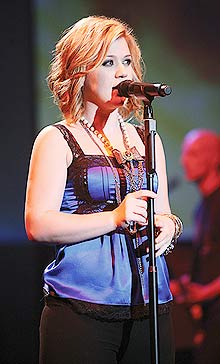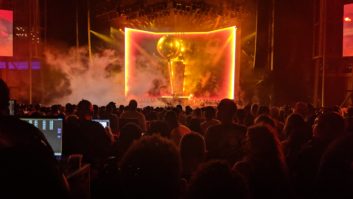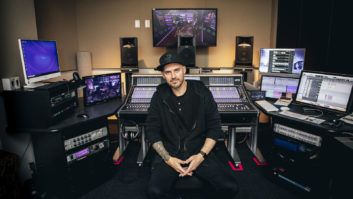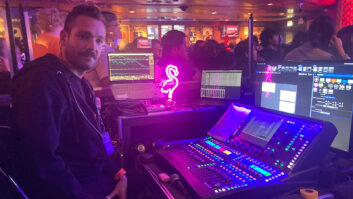

Touring under her third RCA release, My December, Kelly Clarkson has achieved a level of success that’s easily measured by the number of fans she’s garnered since becoming the first American Idol winner back in 2002. (Let’s just say that the crowd can overpower a line array’s output!) My December debuted at Number 2 on Billboard (just behind the Hannah Montana soundtrack, if that’s any indication of who’s out there buying). Her previous release, Breakaway (which features such standout tracks as “Since U Been Gone” and “Because of You”), sold more than 6 million copies in the U.S. alone.
While some may question the true artistry behind American Idol and the subsequent longevity of the winners, Clarkson has shown the world that she can sing and is not just another face in the pop idol world.
Photo: Steve Jennings
Clarkson’s world tour included a stop at the Memorial Auditorium in Sacramento, Calif., where Mix caught up with the singer, her stellar band and, of course, the dynamic duo of front-of-house engineer Kevin Elson and monitor engineer Robert Miller.
JUMP INTO THE FIRE
Both Elson and Miller replaced the previous engineers who had been working with Clarkson. Previous FOH engineer Dave Eisenhower got pulled away to do additional Bon Jovi dates (the Clarkson tour started a few months later than previously planned, overlapping the Bon Jovi tour); Miller filled in the vacant monitor engineer position early on during band rehearsals. So not only were they “fresh” to this tour, but they also inherited their previous counterparts’ gear; fortunately, both Elson and Miller had experience with their respective boards and were able to slide in behind the desk and get straight to work.
Elson mans a Midas XL4, “but I had no problems inheriting that,” he says. “It was [Eisenhower’s] setup that he uses with Bon Jovi, as well; it’s almost duplicate. It was great to walk into.”
Miller agrees, adding that his Midas Heritage H3000 is completely “tapped out. I’ve added all the stereo channels I can add,” he says. “It was already there when I got here, and I really love the console; it sounds great. I would have probably used a smaller console knowing some of the venues we were going to, but, obviously, that wasn’t my choice. But I still like the console.”
ALL ABOUT KELLY
Also adding to the almost seamless personnel changeover is the straightforward mix that Clarkson and band require — little in effects and processing, with just a bump up to spotlight Clarkson’s vocals, which is what the audience came to hear. Over at FOH, Elson works with two TC Electronic 5000 reverbs, with both a short and long plate on vocal (“like a 480 hall on vocal,” Elson adds), and a chorus program and a deep drum reverb. “TC Electronic 2290 for delay and a Yamaha [SPX] 990 for short room for the drum kit,” Elson says. “All the other effects, the band does. So it’s not a lot of processing out front; they kind of do the processing they want and I keep it pretty clean in terms of not manipulating too many sounds. It’s a very straight-ahead show; it’s mainly vocal things that go on.”
Likewise over at Miller’s compound, he’s only using an M5000 reverb on her vocals. “I like that it’s nice and warm, and I don’t really have any issues with it,” he says of the M5000. “It’s always my preferred reverb. And just a little bit of limiting — a Summit TLA 100 — just to top off the high spots a little bit. She projects really well; she has a very strong vocal output, so that’s one of the things I listened for when I got here.”
Miller also employs that M5000 for the backing singers. One of those backing vocalists, Corey Churko, has a little Pro Tools rig that his vocal and guitar go through. It’s pre-EQ’d when Miller gets it the way Turko wants it, “and it comes through myself and Kevin, and it sounds great.”
Clarkson sings through a customized Shure KSM9; the company padded down some of the mic’s internal workings. “She was just destroying microphones and they came up with this a year or two ago,” Elson clarifies. Backing vocalists sing through Shure 58As. The rest of the stage sees a large complement of Shure mics: 91, Beta 52, 57s, KSM32s and 98s on the kit; 32 and 57 on each cabinet of the guitar amps; 52 on bass amp; and 52 (low end) and 98 (high end) for the organ. Despite the large complement of onstage mics, most of the stuff is hidden, “so we don’t have a ton of stage volume,” Elson says.
FLYING HIGH
The tour carries a supply of Clair Bros.’ i3 line arrays: 12 i3s a side with four S4 subs per side. Front-fill comprises four FF2s, Clair’s ribbon front-fills.
Elson also carries Clair Lake processing for system tuning, especially for theaters. “A lot of the theaters we’ve done were three balconies high and [we were] tuning the top two boxes of the i3 to get to the very back of the third balcony,” he says. “In a lot of these theaters, where you’re trying to cover so much space, it’s been a long process; probably 30, 40 minutes of really going into all the nooks and crannies, turning the highs up on a certain cabinet — trying to really fine-tune it. Whereas with a lot of the arenas, you can just go in, crank it up, walk the balconies.
“To get over the crowd,” Elson continues, “I’ll hit 108 [dB] at one point and generally stay right around 101, but there are times when everyone’s singing and the crowd can definitely outdo the P.A. We hit pretty high once everyone’s singing. I tend to mix a bit loud. [Laughs] I figure if I don’t feel it, no one else is feeling it.”
Also onstage are a few “just-in-case” wedges; the entire band is on in-ears, “with some drum thumpers and we do have sidefills, but I don’t normally have them on during the show,” Miller adds. “Most of the band has Ultimate Ears; right now, Kelly is on Future Sonics. She has always been on in-ears, but she’s also had wedges and sidefills.”
Regarding the IEM feeds, “They’re all individual mixes, but it’s really a more high-fidelity thing,” Miller answers. “Kelly’s mix has a whole lot of her vocal in it and then a really nice mix of everything else. Everybody else gets a general mix with the exception that each person’s instrument is just above everybody else’s.”
“There’s a lot of texture because she’ll go from ‘Since U Been Gone,’ which is a full-out pop and sing-along, to a song like ‘Sober,’ which is just acoustic guitar, French horns, strings — just really a very dark, airy song,” Elson says. “There’s just a lot of changes that I do as far as effects and just the approach, which is fun. With one, you’re just banging it straight out in your face, and the next is a really airy tune. It’s fun because they’re going back and forth throughout the show. For me, it’s just making sure they hear her sing, so the biggest approach is concentrating on every word, that it’s understood and heard.”
Sarah Benzuly is group managing editor of Mix, EM and Remix magazines.

WATCH:
Kelly Clarkson Photo Gallery







